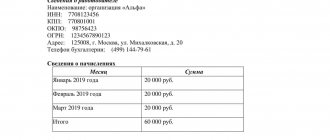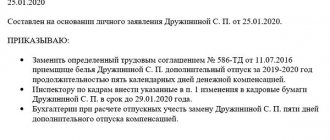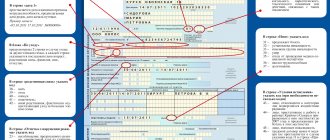When is it necessary to calculate average earnings?
The law establishes dozens of situations when an employee must be paid a salary based on average earnings. But all of them can be divided into two groups:
- "Labor" payments.
We are talking about situations where the calculation of average earnings is provided for by the Labor Code. Most often, this need arises when calculating vacation pay or sending an employee on a business trip. But the Labor Code of the Russian Federation also provides for many other situations when an employee has the right to be paid according to average earnings. This is, for example, a period of training while away from work, forced downtime, etc.
- "Social payments.
Payments for unworked time are provided for not only by labor legislation, but also by social legislation. In this case we are talking about sick leave and maternity benefits.
Let us consider in detail the procedure for calculating average earnings in all these situations.
To include or not to include?
Paragraph 3 of the Regulations clearly excludes financial assistance from the calculation of average earnings. The reason is that they are not included in the wage system. Is this really true?
Question: Sometimes employers pay financial assistance to their former (retired) employees. Such a payment may be made in connection with an anniversary or other significant event in the life of a former employee. Also, financial assistance can be aimed at supporting a former employee in a difficult situation for him (illness, accident, etc.). Are financial assistance to former employees subject to contributions for insurance against industrial accidents and occupational diseases? View answer
Financial assistance is usually provided to an employee by a company in difficult life situations that require large expenses:
- disease;
- unforeseen material damage due to emergency circumstances;
- birth of children;
- death of a family member, etc.
Can an employer make deductions from financial assistance ?
Such amounts do not pay for any work of the employee, do not stimulate him, they are of an irregular nature.
Despite the fact that in Art. 139 of the Labor Code of the Russian Federation (Part 2) mentions “all types of payments” included in the average amount of earnings, but these are still the same “provided for by the remuneration system” payments, to which financial assistance cannot be included.
Question: Are the amounts of material assistance to employees provided for by collective or labor agreements recognized as labor costs for profit tax purposes (Clause 25, Article 255 of the Tax Code of the Russian Federation)? View answer
In practice, situations may arise when the management of a company, using the term “material assistance” in an order, actually issues bonuses to employees, the accrual of which takes place in the billing period. The concept of “material assistance” is absent in labor legislation, which also complicates the issue of classifying certain payments into this category.
At the same time, the legislation does not prohibit calling incentives for work “material assistance.” Taking into account the fact that not all bonuses are included in the calculation of the average salary, confusion may arise in personnel, accounting documentation, and calculations of the income tax base.
For your information! The latter is especially important, because financial assistance, according to the Tax Code of the Russian Federation, Article 270 (clause 23), cannot be included in costs and reduce the income tax base. Payments not designated as financial assistance may be included in the calculation.
The possible way out here is this: when the company actually pays bonuses, but in orders they call it “material assistance,” it is better to abandon the dubious term. At the same time, the LNA (for example, in the Regulations on Bonuses and others like them) should specify exactly what bonuses for a quarter, month, year are paid to employees within the framework of the organization’s remuneration system.
How to tax financial assistance with personal income tax and insurance contributions ?
LNA, as a regulatory mechanism for the payment of wages and equivalent amounts, are mentioned in the Labor Code (Articles 57, 41). When formulating the provisions of the LNA, it is necessary, if necessary, to distinguish between a bonus and financial assistance in regulations; you can rely on the Supreme Arbitration Court Resolution No. VAS-4350/10 of 11/30/10, which defines financial assistance as a payment in order to meet the social needs of an employee.
General rules for calculating “labor” average earnings
The procedure for determining average earnings in all cases determined by the Labor Code of the Russian Federation is established by Decree of the Government of the Russian Federation dated December 24, 2007 No. 922.
The basic rules here are as follows:
- Average earnings are calculated for the last 12 months
- All payments related to work activity are taken into account: salary (tariff), allowances, bonuses, etc.
- Payments for unworked periods (vacation pay, sick leave, etc.) are not included in the calculation.
- If an employee works full time or fulfills production standards, his average earnings cannot be lower than those calculated on the basis of the minimum wage.
The inclusion of bonus payments in average earnings is associated with a number of features (clause 15 of Resolution No. 922):
- Monthly bonuses are generally included in the same way as salaries. But if they are accrued on different bases, then no more than one bonus per month is taken for each indicator.
- Quarterly and semi-annual bonuses, if the accrual period is fully included in the calculation period, are taken in full. If the bonus period and the billing year “overlap” partially, then part of the bonus is used for calculation, which corresponds to the number of “coinciding” months.
- Annual bonuses, long service awards, etc. are taken into account in full if they relate to the year preceding the “average” payment.
A situation may arise where in the previous 12 months the employee did not have income on which to base the calculation. Then use the following options (clauses 6-8 of resolution No. 922):
- Income is taken for the 12 months preceding the billing period.
- If there was no income before the beginning of the current month, then data for this month is used.
- If the salary has not yet been accrued at all, then the calculation is made on the basis of the tariff (salary).
If the organization has experienced an increase in wages, and the billing period “covers” a time with a lower wage level, then it may turn out that payments based on average earnings will be lower than for other employees. To avoid such a situation, the calculated amount must be increased by a factor equal to the ratio of the “new” and “old” salary (clause 16 of Resolution No. 922).
Incorrect determination of the calculation period for vacation pay
Accountants most often make this mistake for the reason that they incorrectly interpret the norm of paragraph 5 of Resolution No. 922, which indicates the time to be excluded from the calculation.
At the time of calculating the average salary of an employee, the calculation period should not include periods such as:
- maintaining the employee's average earnings, in accordance with the provisions of Russian legislation. The exception is breaks for feeding the child, which are illegal to exclude from the calculation.
- receipt by an employee of maternity benefits or in the event of his temporary disability
- downtime due to the fault of the employer or for reasons for which a third party is to blame
- strikes in which the employee did not take part, but was deprived of the opportunity to perform his duties
- providing an employee with additional days to care for a disabled child
If, at the time of preparing the calculation of vacation pay, there are absences in it, the reason for which has not been established, this time is also not subject to exclusion, which corresponds to clause 5 of Resolution No. 922.
Summarizing the above, we can conclude that the following are not subject to exclusion from the billing period:
- breaks necessary to carry out the feeding procedure
- downtime due to employee fault
- strike
- failure of an employee to show up for work due to an unknown reason
- absenteeism
The procedure for calculating “labor” average earnings
The method for calculating average earnings depends on the purpose for which the size of the payment is determined
- Vacation pay calculation
In this case, the average daily earnings (ADE) are determined based on the “conditional” number of calendar days in a month – 29.3.
In the simplest situation, when all 12 months of the billing period are worked out without gaps:
SDZ = FOT / (12 x 29.3)
Payroll - all payments included in the calculation.
But, of course, this is not always the case. An employee could work for less than a year, take sick leave, etc. Then the formula takes the following form
SDZ = payroll (KPM x 29.3 + DNP)
KPM - number of months worked in full
DNP - calendar days falling on time worked in “incomplete” months
DNP = 29.3 / KD x KDR
CD – the total number of calendar days in an “incomplete” month
KDR - the number of calendar days falling on the worked period
- Calculation of average earnings in other cases provided for by the Labor Code of the Russian Federation
If the calculation of average earnings is not related to vacation pay (for example, an employee goes on a business trip), then the formula will be simpler:
SZ = FOT / KD (CC)
KD (KCH) is the number of days (or hours - with hourly accounting) actually worked during the reporting period.
Next, you need to multiply the average earnings by the number of days to be paid. For vacations these will be calendar days, in other cases - working days.
B = SDZ x D
Calculation for vacation compensation
The general formula for calculating the amount of payments will look like this:
SV = SDZ x KDO,
where SV is the amount of payments, SDZ is the average daily earnings; KDO - the number of calendar days that make up the vacation. The KDO also includes weekends, but official holidays are excluded from the calculation.
We are interested in the method for calculating SDZ. It depends on the billing period adopted for this type of compensation. When determining vacation pay, it is 12 months.
The formula for calculations will be as follows:
SDZ = S-12 / 12 / 29.3,
where SDZ is average daily earnings; C-12 – the amount accrued to the employee for the 12 months preceding the vacation; 29.3 is the conventionally accepted average number of days in a month.
SPECIFIC EXAMPLE. Anna Polulevich, an employee of Clipper LLC, receives a salary of 23,000 rubles. In April 2021, she received a bonus of 10,000 rubles. Her annual leave is scheduled to begin on July 18 and will last until August 14, 2021. Before A. Polulevich’s leave, he worked for 12 months in full. We calculate SDZ. To do this, we first decide what amount will be included in the calculation formula. 23,000 x 12 = 276,000 rub. – the amount of payments according to the salary. We add the bonus amount, since it is included in the billing period: 276,000 + 10,000 = 277,000 rubles. Since the one-year period before the vacation has been fully worked out, we will take into account the average number of days in a month as 29.3 for each month included in the billing period: 12 x 29.3 = 351.6 days. Now we can determine the average earnings of A. Polulevich per day for accruing vacation payments to her: SDZ = 277,000 / 351.6 = 787.8 rubles. To calculate the amount that A. Polulevich will be given as compensation for paid leave, it is enough to multiply the found SDZ value by the number of calendar days on vacation, in our example it is 28 days: 787.8 x 28 = 22,058 rubles.
Example 1
Manager Ivanov A.V. goes on vacation for two weeks from January 14, 2019. In 2021, he was on sick leave from October 1 to October 14. The employee's total income for 2021 (excluding sick leave) amounted to 580 thousand rubles.
First, we determine the number of days that need to be taken into account for an “incomplete” month, i.e. for October.
DNP = 29.3 / 31 x (31-14) = 16
Now let's calculate the total number of days per year that need to be included in the calculation:
CD = 29.3 x 11 + 16 = 338.3
Hence,
SDZ = 580,000 / 338.3 = 1714.45 rubles.
Amount of vacation pay for 14 calendar days
O = 14 x 1714.45 = 24,002.36 rubles.
Example 2
Now suppose that Ivanov A.V. sent on a two-week business trip from January 14, 2019. In this case, we need to determine the number of days worked by him in the billing period. The total number of working days in 2021 according to the five-day calendar is 247. Sick leave from October 1 to October 14 accounts for 10 working days. Hence:
SDZ = 580,000 / (247 - 10) = 2,447.26 rubles.
A business trip from January 14 to January 27, 2021 requires 10 working days. Therefore, Ivanov will be accrued for this time
Z = 2,447.26 x 10 = 24,472.6 rubles.
As the examples show, despite different calculation methods, the amount of payments differs slightly (the difference is less than 2%).
Thus, regardless of the reason why an employee is transferred to “average” pay, he can count on comparable remuneration.
Calculation of average earnings for social benefits
Average wages are calculated not only on the basis of labor legislation, but also on the basis of social legislation. When calculating sick leave and maternity benefits, the main regulatory documents are:
- Law of December 29, 2006 No. 255-FZ.
- Decree of the Government of the Russian Federation dated June 15, 2007 No. 375.
The basic rules here are as follows:
- The settlement period is two calendar years preceding the year in which the payment was accrued.
- All payments subject to contributions to the Social Insurance Fund are taken into account.
- It is necessary to comply with limits limiting the amount of payments both “above” and “below”. The maximum amounts of social payments are approved by the Government, the minimum amounts are determined on the basis of the minimum wage.
The procedure for determining average daily earnings depends on the type of social benefit:
- For sick leave, the amount of income for two years is divided by 730.
- For maternity payments, two-year income is divided by the number of calendar days for two years, minus the periods:
— maternity leave;
— temporary disability;
— exemption from work for other reasons, if payments during this time were not subject to contributions to the Social Insurance Fund.
If the employee had no income during the billing period, or if maternity leave occurred during this period, then the two years preceding the billing period can be used. In this case, the payment amount should increase (clause 11 of Resolution No. 375).
If the employee did not have income for the previous 4 years, or if his average monthly income was lower than the current minimum wage, then the minimum wage multiplied by 24 should be used as the calculated amount.
All bonuses accrued in the billing period are used to calculate average earnings, even if the bonus period extends beyond the billing months. The main thing is that the premium amount is subject to contributions to the Social Insurance Fund (clause 14 of Resolution No. 375). Therefore, if an employee receives large bonuses, then it may be “more profitable” for him to be sick than to go on vacation.
But with salary increases the situation is the opposite. To calculate social benefits, a higher level of remuneration is taken into account only from the date of its actual increase. No recalculation is made here, as when calculating vacation pay (clause 12 of Resolution No. 375).
How are previous holidays affected?
The rules for calculating vacation pay are set out in Resolution No. 922 of December 24, 2007. Read more about them here.
To calculate the payment, the employer must take the last year, sum up the income for this time and divide by the calendar days worked.
The resulting average daily earnings are multiplied by the number of days of paid leave.
The calculation process becomes more complicated if the calculation period includes events such as business trips, sick leave, downtime, absenteeism, and previous vacations.
How does past vacation affect:
- excluded from the calculation period for vacation pay;
- payment for the previous vacation is not included in the employee’s income;
- gives the right to days of annual rest, that is, they are included in the length of service.
Similar rules apply for other periods when the employee retained his job and was paid average earnings.
Are they included in the experience?
The answer to this question is contained in Article 121 of the Labor Code of the Russian Federation, which lists those time periods that are included in the length of service and give the right to days of paid rest.
Among the listed events, it is indicated that the right to leave is also given by the time when the employee was absent from work, but his job was retained.
Being on vacation (of any kind) fits the above description.
The employee does not come to work due to a vacation, and no one will take his place; upon completion, he will return to his duties.
Thus, the time spent on regular annual paid leave is included in the length of service and guarantees the provision of rest days in the amount of 2.33 days for each full month (if the annual duration is 28 days).
The length of service also includes study leave, as well as maternity leave. In addition, 14 days of personal leave during the year are taken into account.
Are they taken during the billing period?
An accountant must know exactly what needs to be included in the billing period and what not. This information is necessary for the correct calculation of vacation pay.
According to paragraph 5 of Resolution No. 922, the time when the employee was not at work, but was paid the average income, is not included in the billing period, that is, such rest days must be excluded.
What does it mean?
When calculating vacation pay, the accountant must count the number of calendar days worked during the estimated time. If a month is completely exhausted, it is considered to have 29.3 days.
If the month is incomplete, then the calculations for it are different: the days worked are divided by the total calendar days and multiplied by 29.3.
For example, if in May 2021 an employee took 14 days off, then the days worked for calculating the next vacation pay in May = 17 * 29.3 / 31.
If there was a vacation of any kind in the month, this means that the month is incomplete and the calculation for it is carried out according to the rules specified above.
In addition, those in which there were business trips, sick leave, downtime, and maternity leave are considered an incomplete month.
Do they count towards average earnings?
To calculate vacation pay, the accountant must know the amount of income for 12 months and the number of days worked during this time.
The income that can be taken into account, according to paragraph 1 of Resolution No. 922, includes wages, bonuses, allowances, additional payments to wages and, according to paragraph 5 of Resolution No. 922, does not include payments for periods when the employee maintained average earnings.
This includes the annual rest period.
Paid vacation pay is not counted as income.
How are one-time and annual bonuses and financial assistance taken into account?
Example
Initial data:
Employee Potapova will go on vacation from September 1, 2021. For every full month of work she receives 34,000.
In April 2021, she took 14 days of annual leave, paid vacation pay amounted to 16,000, and salary for this period = 18,000.
Calculation:
How to calculate payment for current vacation:
- The calculation is carried out for the period from 09/01/2018 to 08/31/2019.
- During this segment, 34,000 * 11 + 18,000 = 392,000 were earned.
- April is an incomplete month; 16 * 29.3 / 30 = 15.63 were worked in it.
- Average daily earnings = 392,000 / (29.3 * 11 + 15.63) = 1,160.
- Vacation pay = 1160 * 14 = 16,240.
Example 3
Let's use the conditions of the previous examples and assume that Ivanov A.V. I was on sick leave from January 14 to January 27, 2021. The calculation period in this case will consist of 2021 and 2021. The income of Ivanov A.V., subject to contributions to the Social Insurance Fund, in 2021 amounted to 580 thousand rubles, and in 2021 - 500 thousand rubles.
Then:
SDZ = (580,000 + 500,000) / 730 = 1,479.45 rubles.
Now you need to check whether the calculated amount does not exceed the maximum possible benefit amount.
The maximum base for contributions to the Social Insurance Fund in 2021 and 2021 will be RUB 755,000, respectively. and 815,000 rub.
Therefore, the maximum SDZ for sick leave in 2021 will be
SDZm = (750,000 + 815,000) / 730 = 2,150.68 rubles.
Estimated amount for Ivanov A.V. It “fits” well into this limit, so it can be used. If a specialist’s work experience exceeds 8 years, then he has the right to 100% sick pay, and the accrued amount will be:
B = 1479.45 x 14 = 20,712.30
The example shows that the employee will receive significantly less money on sick leave than he would have been paid in the form of vacation pay for the same time. This is due to the fact that the average salary for sick leave is not recalculated when wages increase in the billing period.
Federal employees
In the context of the issue we are considering, a special category is federal employees, citizens who receive payments for their work exclusively from federal sources of funding (Federal Law No. 58 “On the Civil Service System” dated May 27, 2003).
Federal Law No. 79 of July 27, 2004 “On the State Civil Service” directly provides for financial assistance for civil servants on vacation (Article 50, paragraphs 5-6). A lump sum payment for vacation is also mentioned in this subclause. There is Government Decree No. 562 dated 06-09-07 (“Rules”), establishing the rules for calculating the salary of civil servants who receive payments from the federal budget for their work. This issue is discussed in paragraph 6 of the Rules.
Material assistance, based on clause 1 of the Rules, can be considered a payment not included in the wage system, however, it will be included in the calculation of vacation pay. The legislator has provided a restriction on the inclusion of such amounts in the calculation of average earnings from vacation pay - no more than 1/12 of each payment of financial assistance made in the billing period.
Wherein:
- actual payments are taken into account, and not those provided for by the standard (if any);
- Several types of financial assistance may be included in the calculation.
The tax service spoke about the first situation in letter No. VE-6-16/906 dated 11/23/07, and the second situation was addressed by the Ministry of Social Development, document No. 3495-17 dated 11/15/07.
Attention! Regional and municipal employees, unlike federal ones, do not have the right to include financial assistance when calculating their vacation pay. This is evidenced by both legislative acts of the Russian Federation and established judicial practice.
Results
- In the vast majority of cases, financial assistance is not included in the calculation of average earnings; therefore, it cannot be included in the total for calculating vacation payments.
- An exceptional category is federal employees. Their financial assistance may be partially included in the calculation of vacation payments (in the amount of 1/12 for each payment).
- Municipal employees do not have the right to increase the amount of vacation pay through financial assistance.
- Commercial firms and other organizations that are not subject to civil service legislation must clearly distinguish between the concepts of “material assistance” and “bonus” in their LNA. Financial assistance is not included in expenses for NU purposes.







